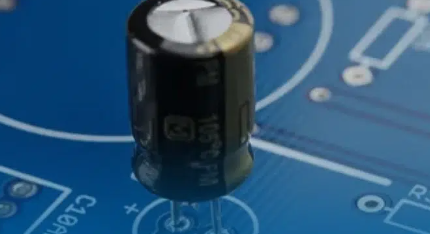- Ameya360 Component Supply Platform >
- Trade news >
- Which is better ceramic or electrolytic capacitor
Which is better ceramic or electrolytic capacitor
Which is better ceramic or electrolytic capacitor
Ceramic VS electrolytic capacitor
Determining whether ceramic capacitors or electrolytic capacitors are better depends on the specific requirements and characteristics of the application. Each type has its advantages and disadvantages. Here’s a comparison between the two:

Ceramic Capacitors:
• Advantages: Small size, high capacitance in small physical packages, low ESR and ESL, a wide range of voltage ratings, and good temperature stability.
• Disadvantages: Capacitance may be less stable with temperature changes, affected by DC bias voltage, the potential for microphonic noise, and limited capacitance values compared to electrolytic capacitors.
Electrolytic Capacitors:
• Advantages: High capacitance values available, suitable for applications requiring large capacitance, can handle higher voltage ratings, cost-effective, compact size relative to capacitance, suitable for energy storage and filtering.
• Disadvantages: Extremely sensitive poles, limited lifespan compared to some other types of capacitors, voltage and temperature limitations, and reliability issues under certain conditions.
In summary, ceramic capacitors are often preferred because of their small size, low ESR, and high-frequency efficiency, making them suitable for applications such as decoupling, bypassing, and filtering. On the other hand, electrolytic capacitors are beneficial when high capacitance values, energy storage, or cost savings are required in applications such as power supplies, audio equipment and industrial control systems.
Ultimately, the choice between ceramic and electrolytic capacitors depends on specific requirements, operating conditions, and trade-offs that must be considered for a given application.
What is the construction and working of electrolytic capacitorConstruction of an Electrolytic Capacitor:
● -Anode: The positive terminal is typically made of aluminum.
● -Cathode: The negative terminal containing a conductive electrolyte.
●- Dielectric: Thin oxide layer formed on the surface of the anode, acting as the insulating layer.
● -Electrolyte: Conductive substance filling the capacitor, making contact with the cathode.
Working of an Electrolytic Capacitor:
●- Polarization: Electrolytic capacitors are polarized, requiring the correct connection of positive and negative terminals.
● -Electrolyte Charging: Applying a voltage causes electrons to flow from the cathode to the anode through the electrolyte, resulting in charge accumulation.
● -Electrolyte Layer Formation: An oxide layer forms on the anode’s surface, serving as the dielectric.
● -Capacitance: The surface area of the anode, dielectric thickness, and electrolyte properties determine the capacitor’s capacitance.
●- Energy Storage and Discharge: The capacitor stores electrical energy and can release it when connected to a circuit.
It’s important to follow manufacturer guidelines and consider factors such as polarity sensitivity and voltage/temperature limitations for safe and reliable usage of electrolytic capacitors.
How do you know if a capacitor is electrolyticDetermining if a capacitor is electrolytic or not can be done through visual inspection or by checking the labelling or markings on the capacitor itself. Here are some ways to identify an electrolytic capacitor:
● Physical Appearance: Electrolytic capacitors typically have a cylindrical or can-like shape and are larger compared to other capacitor types.
● Markings or Labeling: Check for markings or labels on the capacitor indicating its capacitance value, voltage rating, and polarity indicators. Polarity markings (+ and – symbols) suggest that the capacitor is electrolytic.
● Polarity Indicators: Electrolytic capacitors are polarized and have positive and negative terminals. Look for a longer lead or a plus (+) symbol for the positive terminal and a shorter lead or a minus (-) symbol for the negative terminal.
● Manufacturer Datasheets or Specifications: The manufacturer’s datasheets or specifications for the capacitor will provides information about its type, including whether it is electrolytic or not.
By considering these factors, you can determine if a capacitor is electrolytic or of a different type.
How do you determine the polarity of an electrolytic capacitor● Physical signs: Check for obvious physical markings on the capacitor, such as a longer cable or symbols (+ and -), indicating the positive and negative terminals, respectively.
● Labelling: Look for polarity markings or labels on the capacitor’s body or packaging, which may include symbols (+ and -) or words like “positive” and “negative”.
● Color code: Some electrolytic capacitors have colored bands or stripes on the body, where specific colors represent the anode and cathode.
● Data sheets or specifications: Refer to the manufacturer’s data sheet or specifications for detailed information on capacitor pin and polarity configurations.
By considering these factors, you can determine the polarity of an electrolytic capacitor. Remember to follow the manufacturer’s guidelines and markings closely to ensure proper polarity connections for safe and reliable operation.
Online messageinquiry
- Week of hot material
- Material in short supply seckilling
| model | brand | Quote |
|---|---|---|
| CDZVT2R20B | ROHM Semiconductor | |
| BD71847AMWV-E2 | ROHM Semiconductor | |
| RB751G-40T2R | ROHM Semiconductor | |
| MC33074DR2G | onsemi | |
| TL431ACLPR | Texas Instruments |
| model | brand | To snap up |
|---|---|---|
| BP3621 | ROHM Semiconductor | |
| STM32F429IGT6 | STMicroelectronics | |
| TPS63050YFFR | Texas Instruments | |
| IPZ40N04S5L4R8ATMA1 | Infineon Technologies | |
| ESR03EZPJ151 | ROHM Semiconductor | |
| BU33JA2MNVX-CTL | ROHM Semiconductor |
- Week of ranking
- Month ranking
Qr code of ameya360 official account
Identify TWO-DIMENSIONAL code, you can pay attention to


Please enter the verification code in the image below:






















